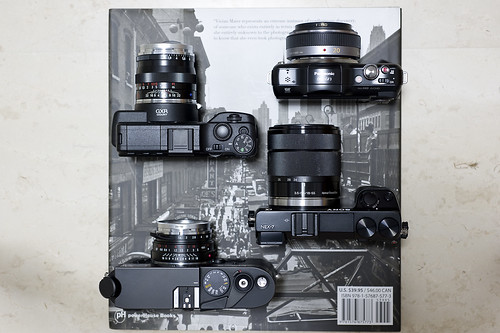In Aug 2011, Sony announced its NEX-7 high-end enthusiast mirrorless interchangeable lens camera. It squeezed vast amounts of the A77's capabilities which added some bulk compared to the rest of the existing NEX models. But it packs a new 24MP APS-C CMOS sensor and 2.4M dot electronic viewfinder into its magnesium alloy body. The NEX-7 will also come with kit set matched with an exclusive black version of the standard E 18-55mm F3.5-5.6 OSS kit zoom. Together with the Nex-7, three new E-mount lenses were announced : the Carl Zeiss E 24mm F1.8 (SEL24F18Z) ; E 55-210mm F4.5-6.3 OSS (SEL55210) ; and E 50mm F1.8 (SEL50F18).


The above 2 images of the Sony NEX7 (500x333 pixels) provide an approx 1:1 to the actual product.
Other images of the product do not nec follow this scale.
Actual measurements are given under "Specifications".
Highlights
New 24MP APS-C CMOS sensor
2.4M dot EVF (with eye sensor)
3.0" 16:9 921,600 dots Tilting rear LCD screen
Electronic first-curtain shutter
ISO 100-16000
"AVCHD Progressive" 1080p60 HD movie recording (with built-in stereo mic)
"Triple-dial-control" and soft key controls
Creative Styles and Picture Effects
Caveat : This is based on a Pre-Production model. Performance of the camera may be tweaked / enhanced for actual production units. But this will introduce some of the features offered, and its performance based on this pre-production model.


The above 2 images of the Sony NEX7 (500x333 pixels) provide an approx 1:1 to the actual product.
Other images of the product do not nec follow this scale.
Actual measurements are given under "Specifications".
Highlights
New 24MP APS-C CMOS sensor
2.4M dot EVF (with eye sensor)
3.0" 16:9 921,600 dots Tilting rear LCD screen
Electronic first-curtain shutter
ISO 100-16000
"AVCHD Progressive" 1080p60 HD movie recording (with built-in stereo mic)
"Triple-dial-control" and soft key controls
Creative Styles and Picture Effects
Caveat : This is based on a Pre-Production model. Performance of the camera may be tweaked / enhanced for actual production units. But this will introduce some of the features offered, and its performance based on this pre-production model.
Last edited:
















































